‘The paintings which I propose to do will depict the struggles of a people to create a nation and their attempt to build a democracy,’ Jacob Lawrence (1917–2000) wrote in 1954 in one of many grant applications. His ambition was to make a narrative series of 60 panels, starting with the events leading up to the American Revolutionary War and ending with the sailing of the US fleet around the world in 1908. By the mid 1950s when he undertook this project, the New York art world had come to favour large-scale Abstract Expressionism over social realism. Lawrence, a historical painter whose style fell somewhere between the two, was falling out of fashion. Though he’d made his name the previous decade with his masterpiece The Migration Series (1940–41), imagining the story of the mass movement of Black Americans fleeing the Jim Crow South to seek better opportunities in the north, he had difficulty securing funds to complete the Struggle series and ended the project midway through, at panel 30.
Against Lawrence’s wishes, and unlike with his other epic narrative series (including visual biographies of Toussaint L’Ouverture, Frederick Douglass, Harriet Tubman, and John Brown), the Struggle panels weren’t kept together. They began changing hands after 1959. As a result of that dispersal, five paintings are unlocated, possibly lost, or unrecognised by whoever owns them presently as belonging to the larger corpus.
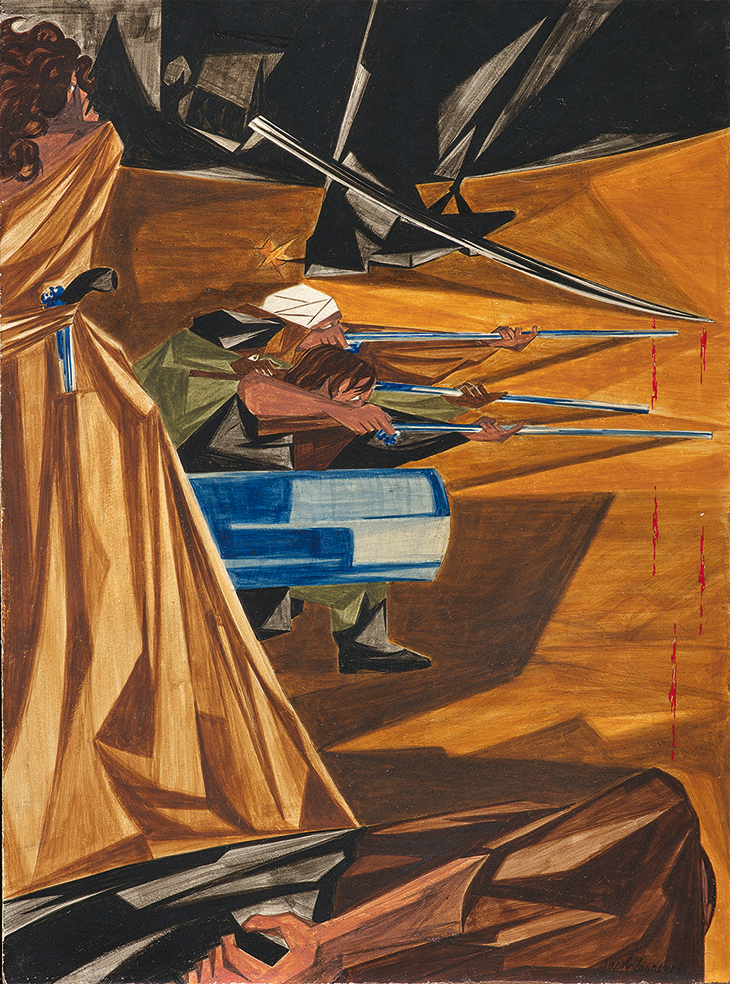
Panel 12 (1955) from Struggle: From the History of the American People (1954–56), Jacob Lawrence. Collection of Harvey and Harvey-Anne Ross. Photo: Bob Packert/PEM; © The Jacob and Gwendolyn Knight Lawrence Foundation, Seattle/Artists Rights Society (ARS), New York
Now, for the first time in more than 60 years, the existing panels of this lesser-known series, Struggle: From the History of the American People (1954–56), have been reunited in an important and timely travelling show, now on view at the Met. This collection of 24 small-scale egg tempera paintings (plus one reproduction) represents historical moments, familiar and unfamiliar, from 1775 to 1817 – ranging from Patrick Henry’s ‘liberty’ speech to westward expansion.
In his rendering of these events as inherently contested and diverse, Lawrence makes central the contributions of women and people of colour. Panel 12 depicts Margaret Cochran Corbin, who manned a cannon with great accuracy in the Battle of Fort Washington in Manhattan, after her husband was killed in action. Panel 18 foregrounds Sacagawea and her brother, rather than Lewis and Clark, whose expedition she helped guide. The artist puts Tecumseh’s Rebellion and a North Carolina slave revolt from 1810 on an equal visual plane with the midnight ride of Paul Revere and the Constitutional Convention. All of these stories, Lawrence suggests, depict struggles against oppression for freedom, even when they contradict each other. Counternarratives abound. Panel 10 reads like an inversion of Emanuel Leutze’s famous monumental canvas, Washington Crossing the Delaware (1851), in that George Washington isn’t leading the charge. Instead of glorifying a single hero, Lawrence gives us anonymous soldiers huddled together in rocking blood-spattered boats, emphasising the violence and sacrifice that made American nation building possible.
As a whole, the series is violent, charged, unified by angular shapes, wedges, vivid earth and jewel tones, weaponry – cannons, bayonets, swords, guns, and blood. The rich colour is owing to layers of rock pigment suspended in egg yolk. Agitated brushstrokes are visible in the dense colour on the hardboard panels. Battle after battle, the artist’s influences are evident: cubism, Picasso’s Guernica, in particular, and Orozco whom he felt was best of Mexican muralists.
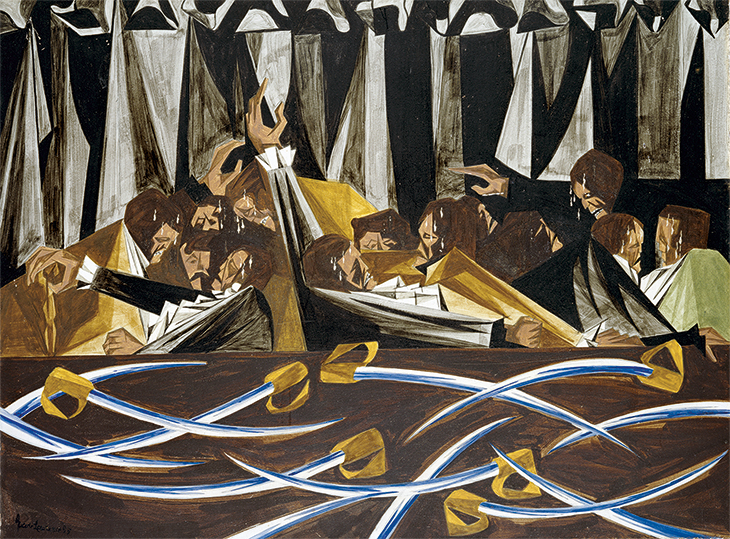
Panel 15 (1955) from Struggle: From the History of the American People (1954–56), Jacob Lawrence. Harvard Art Museums, Cambridge, MA. © The Jacob and Gwendolyn Knight Foundation, Seattle/Artists Rights Society (ARS), New York
I stood for a long while before panel 15, which portrays the Constitutional Convention not at the moment of signing, but in the long and anguished proceedings that preceded resolution, with statesmen sweating and anguished, collapsing in exhaustion behind a table strewn with swords.
Most panels are paired with quotations from historical documents, which the artist researched at the 135th Street branch of the NYPL, now the Schomburg Center for Research in Black Culture, mining archives in new ways. He gathered quotations from eyewitnesses, first-person accounts, petitions, military reports, and famous speeches from named and unnamed people alike that speak across the divides of race and culture voicing a desire for freedom in the face of tyranny. Perhaps the most striking of these texts goes with Panel 5, derived from a petition for freedom made in 1773 by an enslaved man identified only as ‘Felix’: ‘We have no property! We have no wives! No Children! We have no city! No country!’
As a socially engaged painter adored by leftist critics, Lawrence lived and worked under surveillance by the FBI. He painted the Struggle series against the backdrop of McCarthyism, which targeted many Black intellectuals and artists. As he started the series in May 1954, the Brown v. Board of Education Supreme Court ruling called for the desegregation of public schools, catalysing the civil rights movement. In these terms, Lawrence’s project links past and present American struggles that still resonate powerfully today.
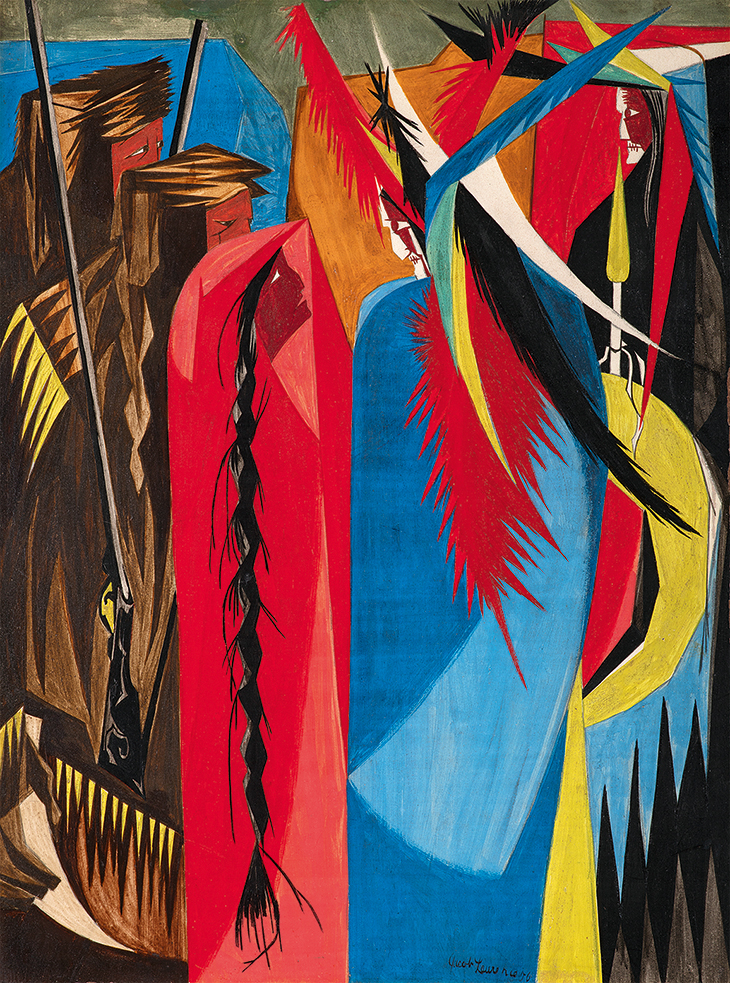
Panel 18 (1956) from Struggle: From the History of the American People (1954–56), Jacob Lawrence. Collection of Harvey and Harvey-Ann Ross.
How shall I describe what it feels like, to witness the series now, against the backdrop of Black Lives Matter and Covid-19, at a moment of political, economic, and public health upheaval in the run-up to a divisive presidential election? The Met has only just reopened, at reduced capacity, with registration for timed entry. To enter, you must stand in a long line to have your temperature taken, and another for security check, and another outside the exhibit to allow for proper social distancing. I and other masked museum-goers were instructed to stand six feet apart as we viewed the art, but it was not easy to obey the stickers on the floor marking where to stand, because the canvases are intimate, only 12 by 16 inches, inviting close attention. It seemed to matter that the paintings have come back to us, now, when there are lives on the line. Our anxious congregation dutifully studied the panels like a book. Here is what they seemed to say: We have never not been in struggle. The country conceived in conflict and combat, debate and divisiveness, remains so.
I grew up in a household with Jacob Lawrence prints on the walls; daughter of a historian of Black American history. I remember my father buying these prints at a gallery in New Orleans. Later, when I was a teenager, he brought me to see The Migration Series when it was shown at the Museum of Modern Art. He was a child of the Great Migration, born in Mississippi, and raised in Michigan, a fighter for civil rights. That the Struggle feels personal to me, as a Black American, made it no less personal to the others in the exhibition hall. ‘He was a genius,’ said the white woman beside me before the final panel, ‘Old America seems to be breaking up…’ Behind her face mask, she was crying. Old America is indeed breaking up. We don’t know what’s to come.
‘Jacob Lawrence: The American Struggle’ is at the Metropolitan Museum of Art, New York, until 1 November.
From the October 2020 issue of Apollo. Preview and subscribe here.
Unlimited access from just $16 every 3 months
Subscribe to get unlimited and exclusive access to the top art stories, interviews and exhibition reviews.

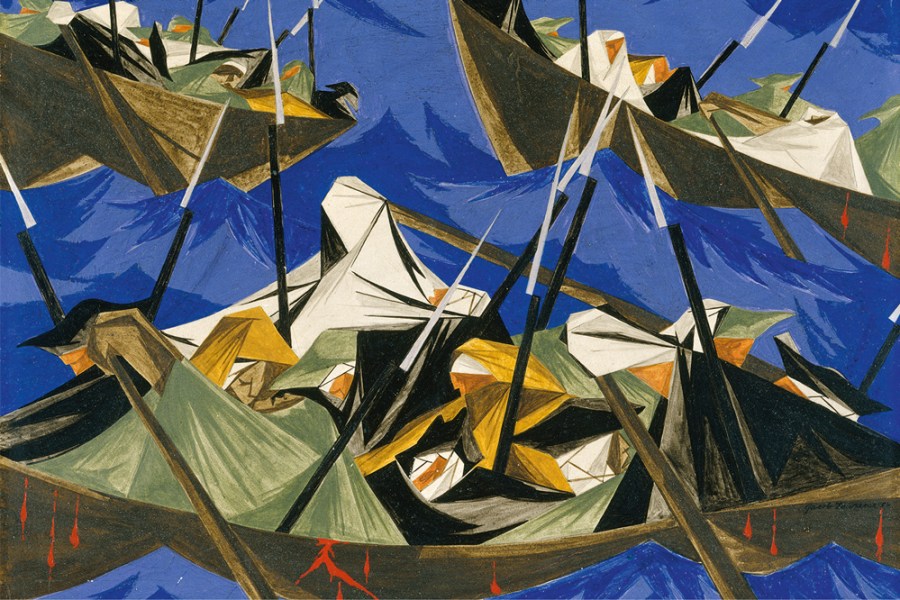
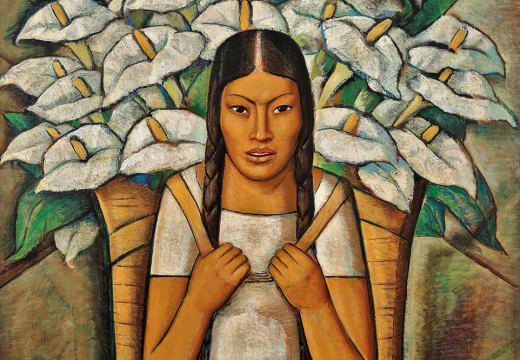
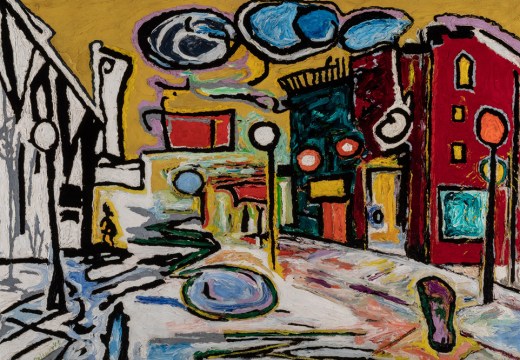
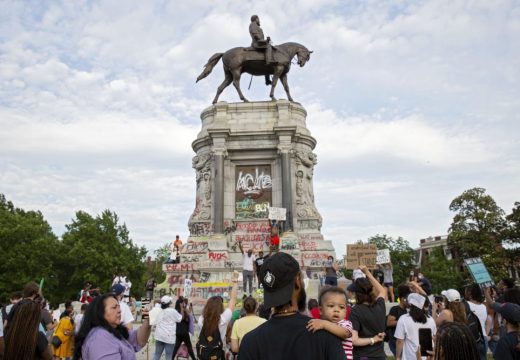









![Masterpiece [Re]discovery 2022. Photo: Ben Fisher Photography, courtesy of Masterpiece London](http://www.apollo-magazine.com/wp-content/uploads/2022/07/MPL2022_4263.jpg)
It’s time for the government of London to return to its rightful home